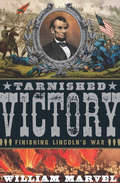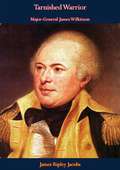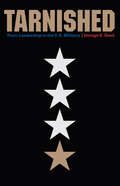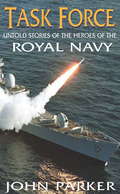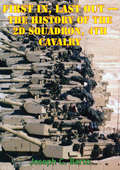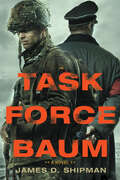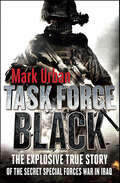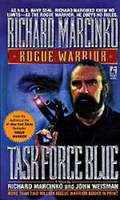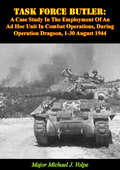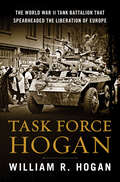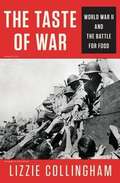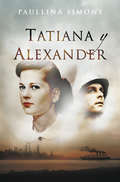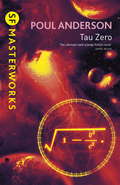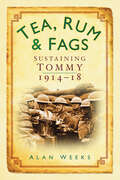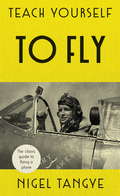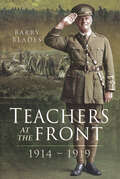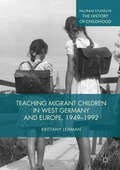- Table View
- List View
Tarnished Victory: Finishing Lincoln's War
by William MarvelA master Civil War historian re-creates the final year of our nation's greatest crisis. With Tarnished Victory William Marvel concludes his sweeping four-part series--this final volume beginning with the Virginia and Atlanta campaigns in May 1864 and closing with the final surrender of Confederate forces in June 1865. In the course of that year the war grows ever more deadly, the home front is stripped to fill the armies, and the economy is crippled by debt and inflation, while the stubborn survival of the Confederacy seriously undermines support for Lincoln's war. In the end, it seems that Lincoln's early critics, who played such a pivotal role at the start of the series, are proven correct. Victory did require massive bloodshed and complete conquest of the South. It also required decades of occupation to cement the achievements of 1865, and the failure of Lincoln's political heirs to carry through with that occupation squandered the most commendable of those achievements, ultimately making it a tarnished victory. Marvel, called the "Civil War's master historical detective" by Stephen Sears, has unearthed provocative details and rich stories long buried beneath a century of accumulated distortion and misinterpretation to create revisionist history at its best.
Tarnished Warrior: Major-General James Wilkinson
by James Ripley JacobsFrom the early days of the Revolution, James Wilkinson was an important figure in American history. As a general in the Army of the United States, he was a friend of Presidents, a companion of conspirators, a master of intrigue, and a confederate of alien and domestic plotters. Few men had more intimate knowledge of the inhabited stretches of the American continent. He knew the slating streets of Montreal and was familiar with the tangled wilderness that covered the Champlain valley. In the old Northwest he traveled on the waters of the Great Lakes, wrangled with the British in Detroit, and ate boiled puppy with the savages along the Ohio. In Kentucky, he peddled merchandise and delivered pioneer women of their children.-Print ed.
Tarnished: Toxic Leadership in the U.S. Military
by George E. ReedBad or toxic leadership, abusive supervision, and petty tyranny in organizations are perennial issues. But to date, there has been little effort to examine the scope and nature of bad leadership in the military. Tarnished rectifies that lack of attention by defining the problems and suggesting possible solutions appropriate to the military’s unique structure and situation. Leadership is central to the identity of the U.S. military. Service academies and precommissioning processes have traditionally stressed the development of conscientious leaders of character. The services regularly publish doctrinal works and professional journal articles focusing on various aspects of leadership. Unsurprisingly, in most of those publications leadership is presented as a universally positive notion, a solution to problems, and something to be developed through an extensive and costly system of professional military education. Leadership expert George E. Reed, however, focuses on individual experiences of toxic leadership at the organizational level, arguing that because toxic leadership has such a detrimental impact on the military organizational culture, additional remediation measures are needed. Reed also demonstrates how system dynamics and military culture themselves contribute to the problem. Most significant, the book provides cogent advice and insights to those suffering from toxic leaders, educators developing tomorrow’s military leaders, and military administrators working to repair the current system.
Tarra: The story of an Army small ship
by Jack PeelTarra describes the 25 years of service provided to the nation by a 125-foot wooden cargo vessel, operated by the Australian Army from her launch in 1945 to her abandonment in huge seas off the north coast of New South Wales in 1965. During the war in the South Pacific, the only mode of transport available to provide food ammunition and supplies to the fighting forces and civilian population to the north of Australia, other than aircraft and pack horses, was seagoing small craft and small ships. The Tarra story follows her launch in Tasmania in 1945, when the ship was employed in dumping ammunition off the east coast of Australia. Based in Newcastle and later in Cairns, she was seconded to the Graves Registration Unit during the establishment of the Bomana War Cemetery near Port Moresby, and then lent to the civil authorities to collect copra from remote islands. Tarra provided the only form of transport for materials and personnel for the construction of the Vanimo Outstation of the Pacific Islands Regiment on the Dutch border in 1952, and she continued to resupply the Company base for the next ten years, making two voyages per year from Brisbane. Tarra and her sister, ship Vasse, played a key role in training soldiers to become sailors, particularly in the Citizen Military Forces and in the development of the Australian Regular Army after the war and during the Pentropic experiment. In declining condition, she was sold to the Societe Marine Caledonian and renamed Milos Del Mar in April 1965. The dramatic rescue of her civilian crew eight months later and her abandonment to sink slowly in rough seas was described on the front pages of major newspapers at the time and by the commander of the Air Force Sea Air Rescue aircraft, thereby completing Tarra's story. Army water transport had been operated by the Royal Australian Engineers however the function was taken over by the newly formed Royal Australian Corps of Transport. Army water transport continues today with landing craft operated by 35 Water Transport Squadron RACT.
Tars: Life in the Royal Navy during the Seven Years War
by Tim ClaytonTars is a gripping firsthand account of life in the Royal Navy during the Seven Years War, from which Britain emerged as the world's major power.Through the lives of the main protagonists - a small band of sailors from across the ranks - Trafalgar author Tim Clayton paints a vivid picture of the navy and the era at its bloodiest and most tempestuous phase, beginning in 1758. From close-quarter battles and roistering on the streets of London to the political decisions that built up and knocked down empires. In this death-or-glory era the navy became the main weapon of an aggressive and power-hungry government, and fighting at sea was carried out at ever-closer quarters and with ever-increasing amounts of firepower. Using never-before published first-person sources, Tars takes us through these men's daily struggles as Britain navigated her course on the political map.
Task Force
by John ParkerThe Royal Navy at the start of the twenty-first century had undergone the most remarkable transformation. The Fleet is today the smallest since the start of the Napoleonic wars as surface vessels are no longer viable as a principal line of defence. That preserve is now in the hands of Britain's nuclear-armed submarine fleet, well chronicled in THE SILENT SERVICE and the Air Force, as outlined in STRIKE COMMAND. This book will complete the triangle of our essential military might, telling the story of today's sea-going ultra-mobile, rapid reaction, missile- and aircraft-carrying task force. John Parker includes personal interviews from the men and women who have served in the Senior Service to bring his story vividly to life.
Task Force
by John ParkerThe Royal Navy at the start of the twenty-first century had undergone the most remarkable transformation. The Fleet is today the smallest since the start of the Napoleonic wars as surface vessels are no longer viable as a principal line of defence. That preserve is now in the hands of Britain's nuclear-armed submarine fleet, well chronicled in THE SILENT SERVICE and the Air Force, as outlined in STRIKE COMMAND. This book will complete the triangle of our essential military might, telling the story of today's sea-going ultra-mobile, rapid reaction, missile- and aircraft-carrying task force. John Parker includes personal interviews from the men and women who have served in the Senior Service to bring his story vividly to life.
Task Force 2-4 Cav - First In, Last Out - The History Of The 2d Squadron, 4th Cavalry [Illustrated Edition]
by Major Joseph C. Barto[Includes 5 tables, 10 maps and 20 photos]Wars have been studied from every viewpoint from the most abstract to the intensely personal. In the case of Major Joseph C. Barto's Task Force 2-4 Cav-"First In, Last Out": The History of the 2d Squadron, 4th Cavalry Regiment, During Operation Desert Storm, war is viewed from the perspective of one man's impression of a volatile, fluid battle.Re-creating his experiences in Operation Desert Storm from pieced together notes, an extensive journal, and a variety of other sources, Barto tells the story of TF 2-4 Cav. From his position as the squadron's executive officer and officer in charge of its tactical operations center, Barto reports the planning and execution of his squadron as it advanced across the desert in pursuit of Iraqis.The end result of Barto's reporting is a uniquely personal view of one man's experience during a rapidly evolving operation. Barto's exercise is not meant to be a polished analysis but rather provides students of military history with an inside view of the operations of a cavalry squadron on a dynamic, oftentimes uncertain, battlefield.
Task Force 58: The US Navy's Fast Carrier Strike Force that Won the War in the Pacific
by Rod MacdonaldThe new breed of American fast aircraft carriers could make thirty-three knots, and each carried almost 100 strike aircraft. Brought together as Task Force 58, also known as the Fast Carrier Task Force, this awesome armada at times comprised more than 100 ships carrying more than 100,000 men afloat. By 1945, more than 1,000-combat aircraft, fighters, dive- and torpedo-bombers could be launched in under an hour. The fast carriers were a revolution in naval warfare – it was a time when naval power moved away from the big guns of the battleship to air power projected at sea. Battleships were eventually subordinated to supporting and protecting the fast carriers, of which, at its peak, Task Force 58 had a total of seventeen. This book covers the birth of naval aviation, the appearance of the first modern carriers in the 1920s, through to the famous surprise six-carrier _Kido Butai_ Japanese raid against Pearl Harbor on 8 December 1941 and then the early US successes of 1942 at the Battles of the Coral Sea and Midway. The fast carriers allowed America, in late 1942 and early 1943, to finally move from bitter defence against the Japanese expansionist onslaught, to mounting her own offensive to retake the Pacific. Task Force 58 swept west and north from the Solomon Islands to the Gilbert and Marshall Islands, neutralising Truk in Micronesia, and Palau in the Caroline islands, before the vital Mariana Islands operations, the Battle of Saipan, the first battle of the Philippine Sea and the Great Marianas Turkey Shoot. The strikes by Task Force 58 took Allied forces across the Pacific, to the controversial Battle of Leyte Gulf and to Iwo Jima and Okinawa. Task Force 58 had opened the door to the Japanese home islands themselves – allowing US bombers to finally get close enough to launch the devastating nuclear bombing raids on Hiroshima and Nagasaki. Task Force 58 participated in virtually all the US Navy’s major battles in the Pacific theatre during the last two years of the war. Having spent many years investigating naval shipwrecks across the Pacific, many the result of the devastating effectiveness of Task Force 58, diver and shipwreck author Rod Macdonald has created the most detailed account to date of the fast carrier strike force, the force that brought Japan to its knees and brought the Second World War to its crashing conclusion.
Task Force Baum
by James D. ShipmanIn the tradition of Saving Private Ryan and Bridge Over the River Kwai, bestselling author James D. Shipman delivers a powerful, action-packed novel based on the true story of General Patton&’s clandestine unauthorized raid on a World War II POW camp. March, 1945. Allied forces are battle-worn but wearily optimistic. Russia&’s Red Army is advancing hard on Germany from the east, bolstering Allied troops moving in from the west and north. Soon, surely, Axis forces must accept defeat. Yet for Captain Jim Curtis, each day is a reminder of how uncertain warfare can be. Captured during the Battle of the Bulge, Curtis is imprisoned at a POW camp in Hammelburg, Bavaria. But whispers say General Patton&’s troops, and liberation, are on the way. Indeed, fifty miles away, a task force of three hundred men is preparing to cross into Germany. What makes Hammelburg so special they don&’t know, but orders are orders. Yet hope quickly evaporates as the raid unravels with shattering losses. For inmates, the liberation becomes a struggle for survival marked by a stark choice: stay, or risk escaping into danger—while leaving some behind. For Curtis, the decision is an even more personal test of loyalty, friendship, and the values for which one will die or kill. It will be another twenty years before the unsanctioned mission&’s secret motivation becomes public knowledge, creating a controversy that will forever color Patton&’s legacy and linger on in the lives of those who made it home at last—and the loved ones of those who did not.
Task Force Black: The Explosive True Story of the Secret Special Forces War in Iraq
by Mark UrbanThe true story of one of the most dramatic and sustained special operations in military historyWhen American and British forces invaded Iraq in March 2003, select teams of special forces and intelligence operatives got to work looking for the WMD their governments had promised were there. They quickly realized no such weapons existed. Instead they faced an insurgency—a soaring spiral of extremism and violence that was almost impossible to understand, let alone reverse. Facing defeat, the Coalition waged a hidden war within a war. Major-General Stan McChrystal devised a campaign fusing special forces, aircraft, and the latest surveillance technology with the aim of taking down the enemy faster than it could regenerate. Guided by intelligence, British and American special forces conducted a relentless onslaught, night after night targeting al-Qaeda and other insurgent groups. Mark Urban's Task Force Black reveals not only the intensity of the secret fight that turned the tide in Baghdad but the rivalries and personal battles that had to be overcome along the way. Incisive, dramatic, exceptionally revealing, the war in Iraq cannot be understood without this book.
Task Force Blue (Rogue Warrior #4)
by Richard Marcinko John Weisman"Moving slowly, steadily across the tarmac through the driving Florida rain, the Rogue Warrior and his team of SEALs have been called into action. Mission: storm a hijacked 727 sitting on a Key West airstrip and rescue the Secretary of the Navy. In a flash of high-tech explosives and automatic gunfire, a hostage is killed - and Marcinko will be the one to pay. Facing a court martial and permanent removal from the Navy, the Rogue Warrior has one more call to answer, from an ultrasecret operative inside the Defense Intelligence Agency (DIA). " "America's worst nightmare has become a reality. The hijackers' roots run deep in U. S. soil: Americans willing to kill Americans to create a government in their own fanatical image. The Pentagon's security has been breached: the arsenal of democracy raided. The DIA needs someone to eradicate the terrorist infrastructure, circumventing the Navy and the FBI. They need Marcinko and his elite SEAL contingent, Task Force Blue. " "Inspired and funded by a politically motivated independent billionaire, the enemy has become a force of right-wing militias and extremists, radical drug gangs, and fundamentalist terrorists - but they have yet to face an adversary like the Rogue Warrior. Accused of murder and pursued by the FBI, operating underground to maneuver through a political, military, and bureaucratic minefield, the Rogue Warrior is right where he wants to be. And, faithful to his ultimate Commandment of SpecWar, there are no rules - Marcinko will win at all costs. "--BOOK JACKET. Title Summary field provided by Blackwell North America, Inc. All Rights Reserved
Task Force Blue (Rogue Warrior #4)
by Richard MarcinkoRichard Marcinko's #1 New York Times bestselling autobiography, Rogue Warrior, brought SpecWar combat out in the open. But only fiction could tell the whole, unrestricted tale in two more explosive New York Times bestsellers—Rogue Warrior: Red Cell and Rogue Warrior: Green Team. Now the Rogue Warrior's back in a raw, authentic novel of relentless action and suspense.When the Rogue Warrior and his elite SEAL team, Task Force Blue, storm a hijacked 727 in Key West, a hostage is killed—and Marcinko must pay. Facing court-martial and removal from the Navy, his is recuited by the Defense Intelligence Agency to erradicate a secret right-wing terrorist infrastructure. Combating a brutal enemy force, and pursued by the FBI, Marcinko maneuvers through a political, military, and bureaucratic minefield, adhering to the ultimate Commandment of SpecWar -- there are no rules -- win at all cost!
Task Force Butler: A Case Study In The Employment Of An Ad Hoc Unit In Combat Operations, During Operation Dragoon, 1-30 August 1944
by Major Michael J. VolpeOn 15 August 1944, an Allied army launched a second amphibious landing against the coast of southern France. The Allies, having shattered German defenses around the beachhead, decided to exploit the chaos in the enemy camp. On 17 August 1944, Major General (MG) Lucian K. Truscott Jr., with no mobile organic strike force assigned to his VI Corps, ordered the assembly of and attack by an ad hoc collection of units roughly equivalent to an armored brigade. This provisional armored group (Task Force (TF) Butler) experienced remarkable success despite a dearth of planning, no rehearsals, and no history of working together in either training or combat. This case study examines the success of TF Butler from the perspectives of doctrinal development in the United States (U.S.) Army, the unit's unique task organization, and the leadership's employment of the unit in combat. The use of ad hoc formations to meet unforeseen situations was not unique to World War II; American units currently serving in the Middle East are regularly assigned units they have no habitual relations with to conduct combat operations. This case study may prove useful in preparing contemporary military leaders for the types of challenges they will face conducting operations in the contemporary operational environment.
Task Force Hogan: The World War II Tank Battalion That Spearheaded the Liberation of Europe
by William R. HoganA fourth-generation soldier tells the story of his father’s tank battalion, the “Spearhead,” that selflessly led the charge on the front lines from Normandy into Germany—against impossible odds, technologically superior weaponry, and a fanatical enemy on its home turf—and the heroes whose sacrifice won World War II.At twenty-eight, Sam Hogan is one of the youngest lieutenant colonels in the US Army. The West Point graduate from Texas stands in the commander’s hatch of his Sherman tank, behind him a steel wedge of seventeen other Shermans of his tank battalion. Two weeks after the now-infamous D-Day landings, Sam is preparing to give the order to advance into the German defenses that enclose the Normandy beachheads. Ahead of Sam lies seemingly impossible odds for survival: technologically superior Nazi tanks, camouflaged anti-tank guns, and infantry armed with new anti-tank rockets. But Sam has prepared for this moment for the past seven years. With a guttural call to move out accompanied by diesel fumes and the squeak of tank treads, Sam and his men begin their long journey to liberate Europe—a journey from which many of them would not return.So begins the story of Sam Hogan and his colorful band of tanker heroes of the Third Armored Division—the “Spearhead”—as they battle on the front lines of some of the war’s toughest fights, from Normandy to the Elbe to the Battle of the Bulge. The soldiers of Task Force Hogan come from all walks of life. There are cooks, tankers, infantrymen, salty old sergeants, and wet-behind-the-ears lieutenants. In common, they have a sense of duty to each other and their country, and the struggle against the most sinister enemy modern history has ever produced.In Task Force Hogan, the story of Sam and his band of heroes comes to life through the writing of his son, Will Hogan—aided by never-before-seen letters, military dispatches, journal entries, and interviews with surviving family of the Task Force. These were the soldiers at the tip of the spear, brave enough to lead the charge and fight against insurmountable odds, and often paying the ultimate price, while liberating French villages and concentration camps as they rolled towards Germany to ultimately win the war. In the pages of this book, Will Hogan finally gives these unsung soldiers the voice and memorial that they all deserve.
Taste of War
by Lizzie CollinghamA New York Times Notable Book of 2012Food, and in particular the lack of it, was central to the experience of World War II. In this richly detailed and engaging history, Lizzie Collingham establishes how control of food and its production is crucial to total war. How were the imperial ambitions of Germany and Japan - ambitions which sowed the seeds of war - informed by a desire for self-sufficiency in food production? How was the outcome of the war affected by the decisions that the Allies and the Axis took over how to feed their troops? And how did the distinctive ideologies of the different combatant countries determine their attitudes towards those they had to feed?Tracing the interaction between food and strategy, on both the military and home fronts, this gripping, original account demonstrates how the issue of access to food was a driving force within Nazi policy and contributed to the decision to murder hundreds of thousands of 'useless eaters' in Europe. Focusing on both the winners and losers in the battle for food, The Taste of War brings to light the striking fact that war-related hunger and famine was not only caused by Nazi Germany and Imperial Japan, but was also the result of Allied mismanagement and neglect, particularly in India, Africa and China.American dominance both during and after the war was not only a result of the United States' immense industrial production but also of its abundance of food. This book traces the establishment of a global pattern of food production and distribution and shows how the war subsequently promoted the pervasive influence of American food habits and tastes in the post-war world. A work of great scope, The Taste of War connects the broad sweep of history to its intimate impact upon the lives of individuals.
Tatiana y Alexander (El jinete de bronce #Volumen 2)
by Paullina SimonsLa conmovedora segunda parte de la trilogía «El jinete de bronce». Embarazada, enferma y absolutamente desolada, Tatiana ha logrado llegar a Estados Unidos. Entregada a la fuerza de las circunstancias y alejada de su convulsionada tierra, la joven comenzará una nueva existencia con la secreta ilusión de que, en alguna parte, el hombre al que ama sea capaz de vencer a las oscuras garras del destino. Mientras, Alexander sufre el hostigamiento de las fuerzas represoras en las gélidas tierras de la Unión Soviética, y tan solo el recuerdo de su esposa, junto con la velada esperanza de que siga con vida, alimenta su espíritu ante la adversidad. Al tiempo que la contienda llega a su final, ambos lucharán contra sus destinos y la desesperación en busca del amor perdido y la inquebrantable esperanza del reencuentro. La crítica ha dicho...«Una historia de amor que te dejará sin aliento.»Daily Mail «Bellamente escrita. Difícil de dejar. Altamente recomendable.»Library Journal
Tau Zero (S.F. MASTERWORKS)
by Poul AndersonThe epic voyage of the spacecraft Leonora Christine will take her and her fifty-strong crew to a planet some thirty light-years distant. But, because the ship will accelerate to close to the speed of light, for those on board subjective time will slow and the journey will be of only a few years' duration.Then a buffeting by an interstellar dustcloud changes everything. The ship's deceleration system is damaged irreperably and soon she is gaining velocity. When she attains light-speed, tau zero itself, the disparity between ship-time and external time becomes almost impossibly great. Eons and galaxies hurtle by, and the crew of the Leonora Christine speeds into the unknown.
Taylor's Temptation (Tall, Dark and Dangerous #10)
by Suzanne BrockmannA Navy SEAL struggles to resist his attraction to his best friend’s younger sister in this romantic suspense from a New York Times–bestselling author .Protecting the innocent is Navy SEAL Bobby Taylor’s passion. That’s why his best friend asked him to look out for his little sister, Colleen. Except that Colleen’s all grown up now, which has Bobby wanting to do so much more than keep her safe . . .
Te prometo un imperio
by Juan VilchesUna emocionante intriga en torno al viaje de Eduardo VIII y Wallis Simpson al Madrid de la Segunda Guerra Mundial. Mientras las tropas nazis avanzan imparables por toda Europa, el recién destronado rey Eduardo VIII y su mujer, la americana Wallis Simpson, plebeya y divorciada, huyen de Francia y recalan en el hotel Ritz, de Madrid. El viaje de Eduardo pone en jaque a las altas instancias políticas y diplomáticas inglesas, alemanas y españolas, que temen que esté tramando alguna acción contra su hermano Jorge VI, el rey tartamudo. Para complicar aún más el delicado equilibrio diplomático, el ayudante de campo de Eduardo aparece asesinado en la habitación contigua a la de los duques de Windsor. Mientras Franco y sus ministros intentan aprovechar esta crisis para beneficiar sus intereses en Europa, el capitán del ejército Arturo Sotomayor y el comisario de la policía Fontecha deberán superar sus diferencias y resolver un caso lleno de obstáculos. Pero ninguno de los dos cuenta con la fiera determinación de Wallis para proteger a su marido y luchar por el trono de Inglaterra, ni con una misteriosa mujer extranjera cercana al círculo de los duques, que sabe más de lo que aparenta... Una apasionante novela en torno a Wallis Simpson, una de las mujeres más fascinantes del siglo XX conocida por el éxito cinematográfico de El discurso del rey, que mezcla suspense y romance, ficción y realidad de forma insuperable.
Tea, Rum and Fags: Sustaining Tommy 1914-1918
by Alan WeeksIt is said that 'an army marches on its stomach', but histories of the First World War usually concentrate on its political and military aspects. The gargantuan task of keeping the British Expeditionary Force fed and watered is often overlooked, yet without adequate provision the soldiers would never have been able to fight. Tommy couldn't get enough tea, rum or fags, yet his commanders sent him bully beef and dog biscuits. But it was amazing how 2 million men did not usually go short of nourishment, although parcels from home, canteens and estaminets had a lot to do with that. Incredibly, Tommy could be in a civilised town supping beer, wine, egg and chps, and a few hours later making do with bully beef in a water-filled trench. Alan Weeks examines how the army got its food and drink and what it was like.
Teach Yourself to Fly: The classic guide to flying a plane
by Nigel TangyeFirst published in 1938, Teach Yourself To Fly was not only one of the very first Teach Yourself books to be published but the first to actually change the world. It was used on the eve of the second world war to prepare pilot recruits and conscripts before they were called for service, and as such it was read religiously by thousands of young men, some as young as 17, and directly impacted on the British war effort.This beautiful new printing of the book captures all of the feelings of that extraordinary time - it's nostalgic, understated, inspiring and very British indeed, warning young pilots, amongst other things, not to feel 'too discouraged' in the event of a crash landing.Technology has changed hugely, but the principles of aviation as they were in the middle of the twentieth century are perfectly summarised in this lovely book. Get hold of the right vehicle, and it really can teach you to fly. What happens when you're up there, however, is your responsibility.Since 1938, millions of people have learned to do the things they love with Teach Yourself. Welcome to the how-to guides that changed the modern world.
Teach Yourself to Fly: The classic guide to flying a plane
by Nigel TangyeFirst published in 1938, Teach Yourself To Fly was not only one of the very first Teach Yourself books to be published but the first to actually change the world. It was used on the eve of the second world war to prepare pilot recruits and conscripts before they were called for service, and as such it was read religiously by thousands of young men, some as young as 17, and directly impacted on the British war effort.This beautiful new printing of the book captures all of the feelings of that extraordinary time - it's nostalgic, understated, inspiring and very British indeed, warning young pilots, amongst other things, not to feel 'too discouraged' in the event of a crash landing.Technology has changed hugely, but the principles of aviation as they were in the middle of the twentieth century are perfectly summarised in this lovely book. Get hold of the right vehicle, and it really can teach you to fly. What happens when you're up there, however, is your responsibility.Since 1938, millions of people have learned to do the things they love with Teach Yourself. Welcome to the how-to guides that changed the modern world.
Teachers at the Front, 1914–1919
by Barry BladesAugust 1914. Flags waved, people cheered and armies mobilized. Millions of citizens throughout Britain responded to the call-to-arms. War fever was contagious. In the far reaches of empire, young men also pledged their allegiance and prepared to serve the King and his empire. Amongst the patriots who joined the colors were thousands of schoolmasters and trainee teachers. In London, students and alumni from the London Day Training College left their classrooms and took the King’s Shilling. In the dominions, hundreds of their professional counterparts in Perth, Auckland and Toronto similarly reported to the military training grounds, donned khaki uniforms and then embarked for the ‘old county’ in its hour of need. Teachers at the Front 1914-1919 tells the story of these men. It recalls the decisions made by men who were united by their training, occupation and imperial connections, but were divided by social and geographical contexts, personal beliefs and considered actions. It follows these teacher-soldiers as they landed on the beaches of Gallipoli, attacked across no man's land in Flanders, on the Somme and at Passchendaele, and finally broke through the Hindenburg Line and secured victory. Many did not survive the carnage of what became known as the Great War. For those who did, wartime officers and men who had been proud to call themselves Tommies, Anzacs, Enzeds and Canucks, returning home presented further challenges and adjustments.
Teaching Migrant Children in West Germany and Europe, 1949–1992 (Palgrave Studies in the History of Childhood)
by Brittany LehmanThis book examines the right to education for migrant children in Europe between 1949 and 1992. Using West Germany as a case study to explore European trends, the book analyzes how the Council of Europe and European Community’s ideological goals were implemented for specific national groups. The book starts with education for displaced persons and exiles in the 1950s, then compares schooling for Italian, Greek, and Turkish labor migrants, then circles back to asylum seekers and returning ethnic Germans. For each group, the state entries involved tried to balance equal education opportunities with the right to personhood, an effort which became particularly convoluted due to implicit biases. When the European Union was founded in 1993, children’s access to education depended on a complicated mix of legal status and perception of cultural compatibility. Despite claims that all children should have equal opportunities, children’s access was limited by citizenship and ethnic identity.
